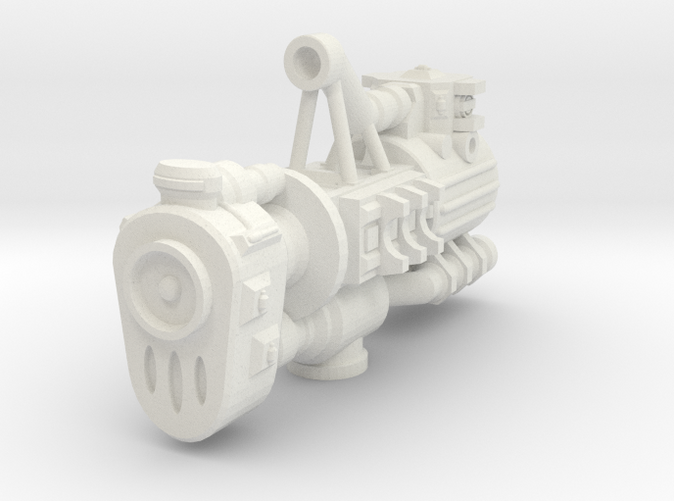Product Description
Xyriat Hegemony
The Yaxir is the Hegemonic Navy’s primary transport and supply vessel Further, it is one of the few that also serves in a civilian capacity as is one of the most common sights in the Xyriat spaceways. Like several Xyriat hull designs, the Yaxir is a venerable design that has had several major refits. The Yaxir hull is no longer in production, but is so numerous that as yet, no major attempt has been made to replace it.
One of the Yaxir’s major roles is as a refuelling vessel. As such, it was designed to be able to interface with the refuelling lances on the larger Xyriat vessels as they would normally with a starbase. The sheer size of the refuelling lances and the typical configuration of the Xyriat vessels made this a somewhat difficult problem to solve. The Yaxirs were initially equipped with two huge refuelling probes, attached on the upper superstructure (where the fuel was stored) that unfolded from the sides.
To start with, this configuration seemed to work, but as the burgeoning Yaxir fleets aged, the refuelling probes began to cause problems. The stresses involved in swinging out the 300-plus-metre tubes took a severe toll on the mechanisms. Even after several attempts were made to reinforce the mountings, this made them increasingly expensive to maintain. While maintenance of the components alleviated this issue for a while, the tubes themselves were starting to suffer. Then, in the space of a year, there forty-four separate incidents of the refuelling probes simply rupturing entirely in both civilian and military instances. Fourteen of these were serious enough that the fuel leak caused damage to one or both of the vessels involved. In the worst incident, an unfortunate confluence of events lead to the loss of a Yaxir and both of the vessels it was refuelling and severe damage to a nearby corvette.
There was furore in the aftermath, as it was revealed that these weaknesses had long been well known to both military and civilian authorities, but had been suppressed due to the expense of solving the issue. The problem had been buried in red tape in the hopes that it would simply never happen. The Omnicron was also most displeased, and thorough purge of all concerned followed.
Solving the issue required a fundamental re-design of the Yaxir. The solution was simple, if perhaps unorthodox. The refuelling probes were removed entirely, and replace with a single, static probe, mounted on the upper hull. To refuel, the Yaxir inverts relative to the target vessel and docks to it upside-down and back-to-front. This keeps the fuel transfer well away from both vessel’s ventral thermal exhausts and their engine wash, both of which could cause potential problems. Precise computer controlled manoeuvring insures that the few tens of metre of clearance is safely maintained. The major downside to this solution is that it is significantly harder to refuel at any degree of sublight speed, as it requires the Yaxir to be moving through its own thrusters or more dangerously, being held by the refuelling vessel’s tractor beams.
This modification necessitated the removal of the front of the upper super structure to secure a mounting point, the blocking the Yaxir’s dorsal cargo ports, formerly the primary way non-fuel cargo was loaded. Instead, six new smaller cargo ports were created on the sides of the vessel’s mid-structure. These were placed between the huge buttresses that had previously heled the refuelling probe in their resting position. Both the buttresses and the primary mounting for the old refuelling probes had been so heavily reinforced that is was simply not cost-effective to remove them entirely.
The cost of refitting the Yaxirs to the new design was enormous, and draining the Hegemonic coffers more than any other single program previously. However, even that cost was smaller than having to replace the civilian and military infrastructure’s most prevalent transport entirely. The Omnicron also required that civilian transport be refitted as well, with a large part of the cost being footed by the organisations and companies that had conspired to suppress the issue.
The Yaxir’s current modification has caused – so far – few issues and the design is expected to serve for more years yet (indeed, the primary reason that no more transport have thus been developed is that expense of refitting the Yaxir fleet).
The Yaxir is well-protected by comparison to many transports, with nine particle beam turrets for point-defence and shields and armour little short of a regular cruiser of its size. It is also only a little slower than the military vessels it supports. Some civilian version, however, downgrade the engines or shields to use the space for more cargo space.
One common variant is the CT01 Yaxir, built specifically for civilian use as passenger liners or cargo vessels. The CT01 version was not built with the refuelling probes. These ships thus escaped the safety issues and thus continue to use the Yaxir’s initial, dorsal loading hold design. This version was also used as the basis for the Handrodar Troop Transport Cruiser.
